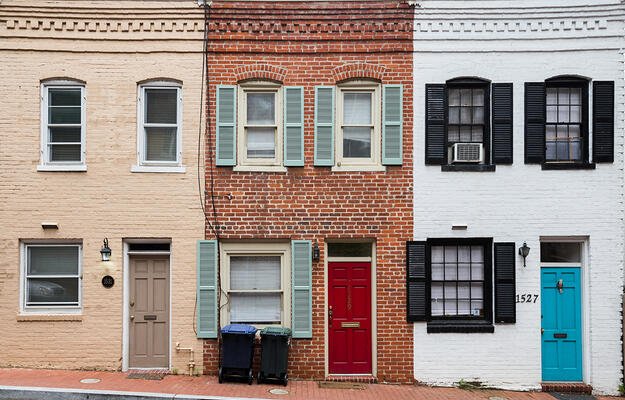
diy13/Shutterstock
No Parking Anytime: How Parking Minimums Impede Transit-Oriented Housing
Perched on the Washington Metro’s Silver and Orange lines, Clarendon, in Arlington, Virginia, is one of many walkable, mixed-use neighborhoods that have sprung up near public transportation hubs in the US. These urban communities, characterized by their high density and diverse transportation options, are commonly referred to as transit-oriented developments (TODs).
When cities build dense housing around transit hubs and plan new transit stations to allow for nearby residential development, they’re often aiming to create more sustainable urban environments and bolster local economies.
However, achieving these goals requires city governments to rethink land-use and zoning policies in areas surrounding public transport stations. Parking minimums, in particular, can significantly impede TOD construction, locking prime real estate for transit-oriented housing behind sprawling parking lots. Eliminating or curbing parking minimums at the municipal level could open up considerable land for transit-oriented housing developments and build more sustainable urban communities.
What is TOD?
TODs are typically mixed-use, dense, walkable communities close to transit hubs, such as bus, heavy rail, and light rail stations. They often include commercial and office uses alongside residential space and are intended to make housing and workplaces more transit accessible. Using public transportation to reach their homes and jobs within cities, rather than traveling to car-dependent suburban neighborhoods and corporate complexes, is especially popular among young urban residents and office workers.
Because it reduces regular car use, TOD has environmental and sustainability benefits: shorter commutes and less automobile dependence among residents result in far smaller carbon footprints and a sharp decrease in greenhouse gas emissions relative to low-density urban spaces farther from public transportation.
TOD is additionally well suited for affordable housing. Affordable housing in the United States often lacks easy access to transit, and the transportation costs low-income households incur often offset the savings from affordable housing. Building affordable transit-oriented housing can increase savings for low-income households and optimize transit use, as people with low incomes are more likely (PDF) to take transit than their high-income counterparts.
Building transit-oriented housing, which tends to be denser than automobile-focused communities, thus allows residents to unlock lower transportation costs by making travel accessible, breaking down barriers such as car ownership and lengthy traffic-choked commutes.
Parking as a barrier and potential policy solutions
Land surrounding many transit hubs is often used inefficiently. Urban trains often have parking minimums that prevent TOD by covering land for thousands of potential homes in asphalt. Revisiting parking minimums could help promote housing construction.
This includes repurposing land currently reserved for park and rides for development. Surface parking lots can also dissuade potential transit passengers living nearby from walking to stations, stifling transit use and reinforcing car dependency. Eliminating overbearing parking minimums on transit could encourage more construction of TODs in areas where such development would have otherwise been impossible.
Several local policy changes could make urban areas friendlier to TOD. One option is to reduce the amount of parking spaces required for transit stations and nearby buildings. There is little need for parking at the scale currently suggested by many local regulations. A 2017 study found TODs in five major cities generate a demand for parking that fills only half of the spaces allotted by planning standards. Hartford, Connecticut, and Buffalo, New York, eliminated parking minimums altogether in 2017, showing such change is feasible at the municipal level. Arlington County, Virginia, meanwhile, has adopted an approach to urban planning that focuses on high-density, mixed-use development in areas around rapid transit stations, which has allowed for a corridor of walkable transit-oriented communities—including the aforementioned Clarendon—to emerge.
Implementing shared parking (PDF) agreements, in which parking for multiple developments are combined, can also cut down on the overall space around transit taken up by parking. Creating exceptions to existing parking regulations and minimums in corridors best suited for TODs, as has been proposed in Chicago, can open the door for limited, yet effective, TOD.
Much of the burden for these changes falls on city governments and local officials, especially zoning and planning boards, which are responsible for setting ordinances that determine land-use standards for future development. Transit agencies and developers also play a significant role in this process, and their cooperation is key. Transit agencies can take initiative to eliminate or reduce park and rides and plan transit expansions with the aim of facilitating future transit-oriented development. They can also lease valuable real estate to developers to allow for housing construction while providing a much-needed source of revenue for transit agencies reeling from pandemic-related ridership decreases.
Properly executed TOD can have far-reaching quality-of-life and environmental effects, creating residential and commercial spaces that can be accessed without automobiles. Eliminating parking minimums or reforming existing parking land-use regulations through shared parking spaces can help open the door to thousands of new homes in dense, walkable communities that are more sustainable and livable than car-dependent communities. Rather than being notable exceptions, Clarendon and similar neighborhoods can be a model for building communities that prioritize sustainability and livability by putting people and transit first.


